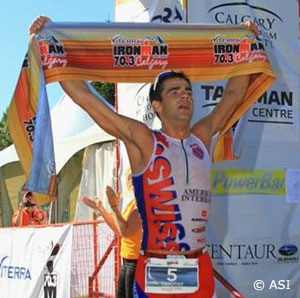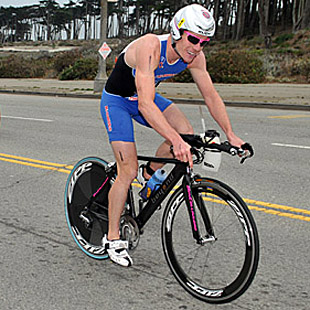Tenille runs Kenya
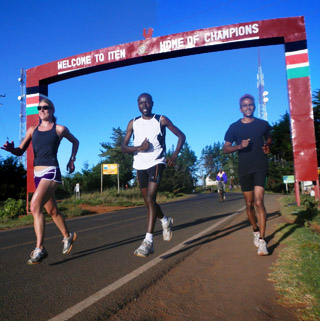
Tenille Hoogland grew up in Victoria, British Columbia and at the age of 7 she took up synchronized swimming. At the age of 17, she was a silver medalist in the synchronized swimming Duet and Team events at the Canada Winter Games and was nominated for the British Columbia Athlete of the Year. She abandoned that sport in 1996 and shied away from athletics sports for nearly a decade as she acquired a bachelor’s degree in Psychology and a Masters in Public Administration and focused on her job as a senior planner in the Canadian government. In 2005, drawn back to sport, she finished first overall woman at a local Olympic distance triathlon. The next year, she got her elite card and over the next few years she established herself as a promising triathlon talent.
After suffering labral tears in both hips in 2009 and early 2010, Hoogland moved to Austin, Texas, started to train with coach Zane Castro and had breakthrough wins at the ITU Pan-American Cup at Treasure Island and the San Francisco Triathlon at Alcatraz — and took an encouraging 4th place moving up in distance at Calgary Ironman 70.3. In 2011, highlights included a 4th at Wildflower long course, a win at Calgary 70.3, and a 2nd place at Rev3 in Anderson, South Carolina. Lowlights included leading up to Mile 11 of the run at Austin 70.3, whereupon she dropped out with physical issues.
Thanks to a first pack swim and a very strong bike, Hoogland seems destined for major success – if only she could ramp up her run. While winning Calgary 70.3 this year, her big lead after the bike was whittled down to 6 seconds at the finish because of a 1:38:00 run split. Undeterred, she worked hard to improve her running form and scored a PR 1:27:44 half-marathon at Rev3 Anderson, only surrendering her lead to Magali Tisseyre at the 11th mile.
At age 33, Hoogland believes she can reach the next step with her running. So this off season she decided to take her quest to unlock the runner within to Kenya. This interview was conducted by email as she lived and trained in Kenya.
Slowtwitch: What impelled you to go to Kenya?
Tenille Hoogland: Running for me has been my weakest link in triathlon. Prior to coming to the sport, I had very little running background. Only after being injured (labral tears in both hips) did I understand that practicing proper running form is essential to have longevity, speed and fun. I have spent the past year working on form. I decided that what better place to be than Kenya to now fully embrace the culture and joy of running and to, of course, get faster!
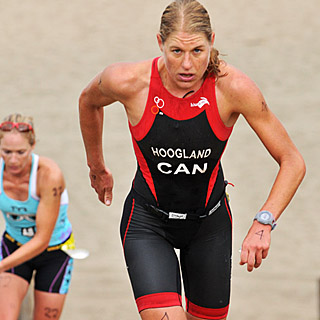
ST: Why this off season?
Tenille: When I returned from my first trip to Kenya four years ago, I told my brother Cameron that one day we would travel together to see the phenomenal wildlife. Holding me to that promise, coupled with my desire to spend quality time improving and focusing on my run (and also to initiating discussions to bring increased participation of triathlon to Kenya) caused me to jump in with both feet at the opportunity to be here.
ST: Tell us about your brother?
Tenille: Cameron is an inspiration to me. Eighteen years ago he was in a very serious work-related accident in which 1200 pounds landed on his head. He is what you call a miracle and since that time has faced and overcome many challenges. When the going gets tough for me in a race or in training, I sometimes think of him and his strength — but mostly of his courage. Cameron taught me that it only takes putting one foot in front of the other to keep going. Traveling around the world to in my previous job and now to train for and race triathlon, I haven't always been around. This July and August I moved to Courtenay, British Columbia, and became an integral part of my family's life rather than keeping in touch through phone calls and email. During that time, Cameron and I found a rhythm together, a connection, and started to dream about this trip.
ST: Why do Kenyan runners inspire you?
Tenille: The strongest image I had of Kenyan runners was in my previous hometown of Ottawa at the Ottawa Marathon. They ran with incredible grace, style and speed. In addition to this, having previously traveled to Kenya, I could appreciate some of the challenges that they overcome to become the phenomenal athletes that they are. They race for opportunity, their village and life. Watching them run is to see hope, determination and spirit. It is beautiful and inspirational.
ST: Do you have Kenyan friends who’ve given you insights?
Tenille: One of my massage therapists, Kiplimo Chemirmir, comes from a village near Iten in Kenya. What struck me the most about him is that in addition to understanding the human body completely, his knowledge of the mental aspect of training, racing and recovery in connection with the body is what makes the difference between a good and a great athlete. It is this quality that Kenyans possess that I think is not recognized as much. They are mentally as strong and prepared as they are physically.
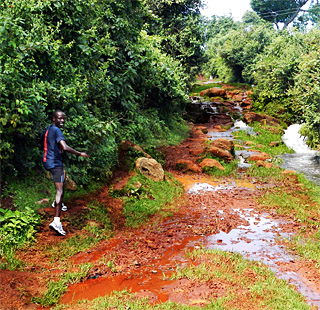
ST: Where are you staying?
Tenille: I am staying at the High Altitude Training Centre [HATC] in Iten. The centre was established by Lornah Kiplagat in 1999. Since that time the HATC has grown to include a fully equipped gym, a 25 meter pool, lounge area (with a cappuccino maker and satellite TV), 2 kitchens, conference area, and 36 double capacity rooms. The HATC has been host to some of the most accomplished athletes in the world including Wilson Kipsang, Wilson Kiprop, and Paula Radcliffe, who just finished a training block here. Darren Smith, coach of Lisa Norden and Sarah Groff, came here with his group in 2010 to train. Iten is a multicultural place hosting an incredible diversity of world class athletes.
ST: Who are some of the athletes you are running with?
Tenille: I run with several incredible people staying here at the training centre. Tony is a Kenyan runner who is recovering from an accident on a motor bike. Ian O'Riordan is a fantastically witty Irish journalist and runner. And, until recently, I also ran with Frederick Edlund, a Swedish ultra-distance runner. Training here I have found that, in keeping with the Kenyan way, working together is best. I have been able to count on numerous people here to keep me going and to help me appreciate the land and running here. I also have been able to count on my coach Zane Castro back home in Austin, Texas, who is trying to help me stay on track and keep the big picture in mind. I follow his program and without his guidance to anchor me, I would likely overtrain and injure myself trying to keep up with the Kenyans.
ST: How do the Kenyan runners explain their philosophy?
Tenille: Iten, at 2500 meters altitude, is where a lot of the base work is done. Kenyans do not expect to develop speed here as it is too high – this is done at 1900 meters in Eldoret, which is close by. The rhythm of the sessions that many Kenyans go by is track on Tuesday, fartlek on Thursdays, and long run on Saturdays. Sundays are off and the other days are recovery based. They make each of their sessions count and really use each other to push the pace and efforts. You often see groups of 10-15 people together and very rarely do they ever run alone. Running is very serious business. When they are running, people, cars, cows and goats stay out of their way. I think many people do not understand just how mentally tough Kenyan runners are. I believe this is what makes them the best in the world.
ST: Running in Kenya must be feast for the senses?
Tenille: The morning begins with the birds singing and roosters crowing. The sun comes up in a bright red glow, the ground is damp with dew and the air is fresh. as I meet my new running friends for our early morning wake up jog. There is an expression in Kenya that is very fitting. It is “pole, pole,” meaning, “slowly, slowly.” This is what you have to do when you arrive at an altitude of 2500 meters or 8000 feet. The run starts slowly as we feel our way on the hard packed red dirt road. It is quiet except for the sound of our own breathing. We are not alone as there are streams of other runners also silent on the road. Despite the fact that we are all running “easy,” I note that Kenyans run with the fluidity of water. They move easily in and around the land – it is almost a dance. We are together but alone in our thoughts, at least until one of us says, ‘Wow this place is incredible!’
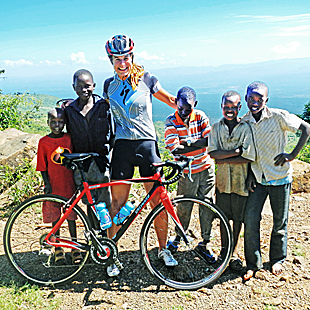
ST: Does that tempo change as the day progresses?
Tenille: The afternoon runs are very different as there is busy life happening all around. People are walking to or from town with jugs for water, petrol or milk – or they might carry loads of heavy grasses for repairing a roof on their 25 kilogram bicycles. Young boys are often along side the road watching their cows graze. The small wooden kiosks or stores are open for business to sell bananas, paw paw (papaya), avocados, cabbage, mangos and oranges that are grown only a few kilometers away.
ST: Do you encounter everyday Kenyans during your runs?
Tenille: Our run starts by going under the “Welcome to Iten Home of Champions” archway. From that high point everything is downhill, which means you always inevitably end your run climbing back up. The terrain here is never flat. As soon we leave the main road, we are greeted by kids with their enthusiastic “how are you how are you how are you?” They wait and watch for our response. It is a game. I sometimes try to preempt them and ask them first or say “Jambo!” They laugh and often then decide that it is time to run with the muzungu (white person). These young chlldren are usually barefoot or, if lucky, wear flip flops. The girls are often in dresses and boys with pants rolled up. When they run it is sometimes with an intensity and focus of an elite runner. Other times they are giggling the whole way. No matter what, though, their form, I note, is perfect, their breathing even and calm. This is joy for them. It is all for fun.
ST: Can you describe a typical route on your daily runs?
Tenille: Our route takes us down a dirt road until we come to a small path that cuts through a corn field. From there we hop over a stream and up a field of grass. Tony, with his long limbs, bounds up the steep climb. I watch, try to imitate — and succeed for the first 10 steps. Then the altitude hits and I have to slow down in hopes of finding a little more oxygen. I chase after him – slowly. This day, like the one before, is perfect. The sun is shining, warm but not too hot. The run finishes going along another dirt path that takes us through grazing land, an old bee farm and alongside mud hut homes. I wonder how it is that life can be so simple and yet so unbelievably full. As we near the end, of course running up a hill, I am completely satisfied. This wasn't a workout I had to tick off for training, to be stronger, that will get me faster. It was just about being alive.
ST: What could you not have foreseen or imagined until you got there?
Tenille: I knew generally that the environment of running was going to be rich. I did not know though that the HATC would be as sophisticated and focused on providing such a perfect training experience. Everything at the centre is aimed at the athlete. It is no wonder that most people come back again and again. Or , in my case, just don't want to leave!
ST: Did any Kenyans express a curiosity about or wish to try triathlon?
Tenille: Yes! The main challenge is the swimming aspect of the triathlon. Sound familiar? The difference though is that Kenya does not have a swimming culture and lack of access to pools is another issue. I believe that if given an opportunity to learn they would be phenomenal!
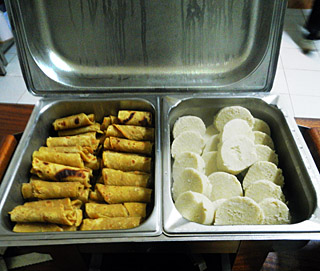
ST: What is the food like?
Tenille: Here at the HATC life revolves around the meals. They are absolutely amazing. All the food comes from the garden which is right below the kitchen. It is organic, nutritious and delicious. Again each meal is prepared with the athlete in mind. They are incredibly accommodating as well to make sure you have what you need to be your best. Every meal we leave absolutely content and stuffed wondering how we can be hungry again in a few hours. Somehow we always are!
ST: What are the conversations like?
Tenille: The conversations have been rich and diverse. As the athletes come from all around the world, we are able to share different training and racing experiences, philosophies on training (e.g., the true value of core workouts), nutrition (Paula Radcliffe is not above having a few pieces of quality chocolate for breakfast!), whether Chrissie Wellington should boycott the BBC Sport Personality of the Year Awards among other topics. There is never a lack of conversation.
ST: What key things can you take away from that experience – for triathlon, for sport, for life?
Tenille: I think that this experience has given me a greater appreciation for the value of camaraderie in training, has shown me the absolute joy in running and has also reminded me what is essential in training hard – recovery. Without the need to drive, cook, grocery shop or do other life stuff, training can be a priority everyday. Finally being here in Kenya I am reminded how very rich we are in life to do a sport like triathlon. It is a privilege.
ST: What were some surprising things about their habits of running? Drinking? Eating? Rest? Recovery? Other modes of training?
Tenille: The main staple of the Kenyan diet is Ugali, a corn meal based dish which is complemented by beans. Chai, a milky tea, is also an essential part of their diet and used for a recovery drink. Training wise, Kenyans are very well attuned to understanding and using slow runs for muscle recovery. They also don't all subscribe to the philosophy that gym work (core and weights) is necessary. Some do it and some don't. It is an individual choice.
ST: Were you the object of some good natured fun?
Tenille: Not really. I have become good friends with many of the people that work here at the HATC. But I did try to learn how to make chipatis, a flat bread, and was almost kicked out of the kitchen. Apparently my fine motor skills need some work when handling dough.

ST: What if anything translates most directly to triathlon?
Tenille: All of this directly relates to triathlon. Running is my focus here but what I am learning from this supports my mental toughness in triathlon in general. I do know that after every session I do here at 2500 meters altitude, I am getting stronger. When I put my toe on the line in 2012, there is no doubt that I will have my experience here in Iten in the forefront of my mind.
ST: How much did it cost? How could others do it?
Tenille: The cost to stay here at the HATC is very reasonable — approximately $50 USD per day. This includes lodging, all meals and the facilities. The centre is not only for elite/professional athletes but for all those that are interested in being in a relaxed healthy training environment. The process is easy. Contact info@lornah.com or look at the website which has information (www.lornah.com). Then book your time. You will never regret.


